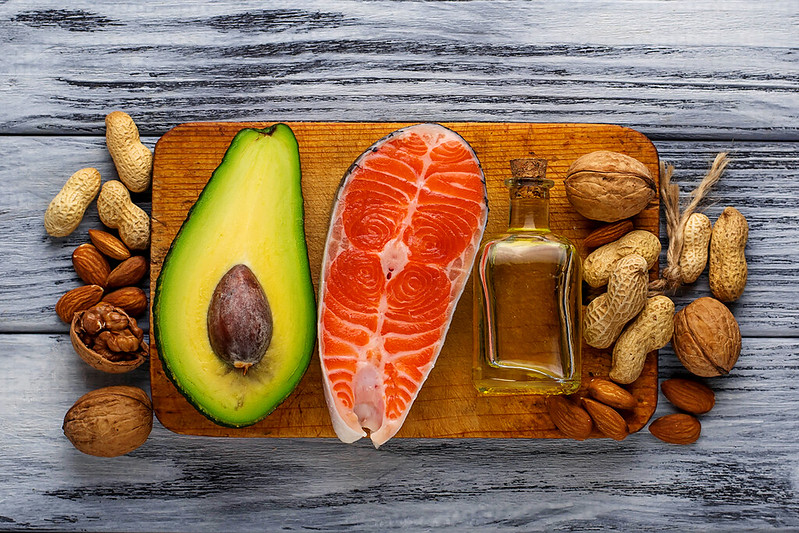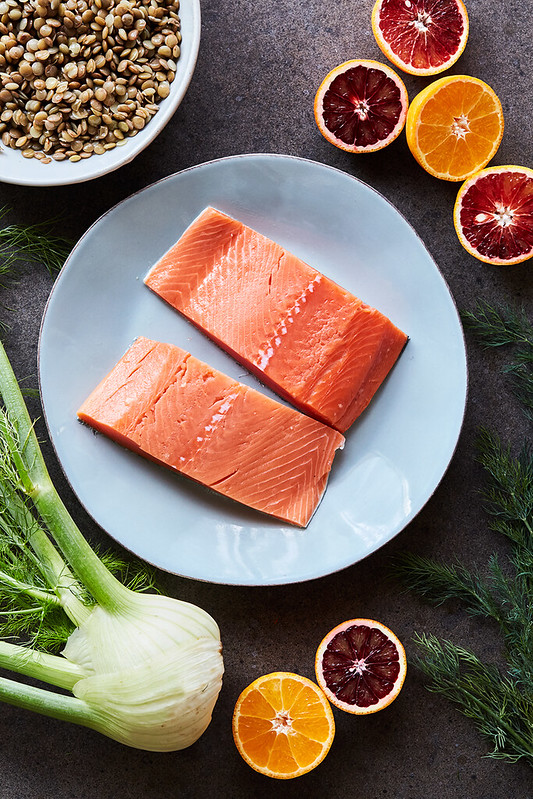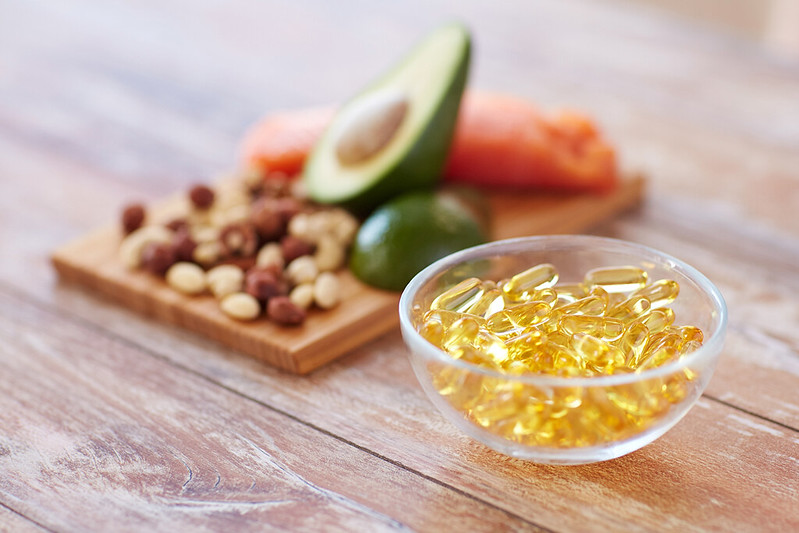Omega-3 Fatty Acids are essential and incredibly important for your body and brain. They are essential because they MUST be obtained through our diet. Read on for science-based health benefits of omega-3s, why they are so important and everything else you need to know.
At this point, you know how I feel about fats and the importance of including quality fats in our diet. Today we are going to talk more specifically about essential fatty acids. The two most well-known polyunsaturated fats are omega-3s and omega-6s. Both are considered to be essential fatty acids, because our body needs them and we cannot produce them on our own. It is important that we get these essential fats from our food. The human body can create most of the types of fats it needs from other fats or raw materials, but for these essential fatty acids, this isn’t the case.
Since we’ll be talking almost exclusively about omega-3s in this post, I do want to quickly first address about the “other” EFA. The essential fatty acid, linoleic acid (LA) is an inflammatory omega-6 fat. While that word “inflammatory” may sound bad to you, this is your reminder (we’ve talked about it before), that inflammation is quite important in our body, as part of proper healing. For example, you whack your head and get a swollen goose egg, that little bump is just one example of inflammation and it’s actually quite important to the healing process, as the inflammation sends nutrients and blood flow to that area for it to heal. Adequate omega-6 fatty acids, make this inflammation possible. That said, an excess of omega-6 fatty acids, as you can imagine can promote chronic and excess inflammation, which we all know can promote a wide array of diseases.
While both omega-3s and 6s are essential to the body, due to our modern diets that tend to effortlessly be abundant in omega-6 fats, most people are severely deficient in omega-3 fatty acids, so the ratio is severely imbalanced for many. Let’s talk about how we can fix that and why it’s important.
Understanding EFAs and Why Omega-3 Is Most Coveted:
The omega-3 fatty acids were first discovered in the early 1970’s when Danish physicians observed that Greenland Eskimos had an exceptionally low incidence of heart disease and arthritis despite the fact that they consumed a diet high in fat. These early studies established fish as a rich source of n-3 fatty acids.
EFAs are the good fats necessary for hormone production and they are important for normal growth, especially of the blood vessels and nerves and to keep the skin and other tissues looking youthful and supple as a result of their lubricating quality. Omega-3 fats are an integral part of cell membranes throughout the body and affect the function of the cell receptors in these membranes. They provide the starting point for making hormones that regulate blood clotting, contraction and relaxation of artery walls, and inflammation. They also bind to receptors in cells that regulate genetic function. Likely due to these effects, omega-3 fats have been shown to help prevent heart disease and stroke, may help control lupus, eczema, and rheumatoid arthritis, and may play protective roles in cancer and other conditions. 1https://www.hsph.harvard.edu/nutritionsource/what-should-you-eat/fats-and-cholesterol/types-of-fat/omega-3-fats/
In the typical America Diet it is far easier to get omega-6 EFAs (linoleic acid) than the omega-3 EFAs (alpha-linolenic acid). While omega-6 on it’s own from quality sources, isn’t a villain, for most people their excessive omega-6 consumption is coming from non-whole food sources like highly refined plant and seed oils (including corn, canola, safflower, sunflower and, soybean oils), which we already know to be toxic, food-like-substances we are best to avoid. These are the oils most typically found in restaurants, fast foods and other foods of convenience, like packaged, processed foods. Most folks are getting hit with omega-6 fatty acids from many places, while simultaneously not consuming enough omega-3 fatty acids. Other sources of omega-6 fats are grains, legumes, nuts, seeds, poultry (even the organically grown) and industrially raised meat. So it makes sense that adequate (if not far more than) levels of omega-3 fats are effortlessly consumed.
- The human body does best with a ratio of omega-3 to omega-6 fats somewhere in the range or 1:1 to 1:4. Unfortunately most Americans are existing in a ratio upwards of around 1:20, and many have NO detectable level of omega-3 fats, at all.
- Balancing this ratio takes special care to reduce the amount of highly-refined, non-nutrient dense, omega-6 abundant foods in our diet (processed foods, fried foods, fast food, vegetable oils, etc) and consistently including more preformed omega-3 rich seafood (or algae).
- For what it’s worth, grass-fed meat contains 5 times the omega-3 fats as conventionally raised meat and lower levels of omega 6 fats. 2https://www.ncbi.nlm.nih.gov/pmc/articles/PMC2846864/ Grass fed beef’s ratio of of omega-3 to omega-6 is 1:1 where as the ratio in conventionally raised meat is more like 1:7.
Omega-3 Fatty Acids are Important:
- Omega-3 essential fatty acids reduce inflammation, promote cardiovascular health, protect your brain and help prevent metabolic syndrome and chronic diseases. 3https://www.ncbi.nlm.nih.gov/pubmed/23794360
- The human brain is primarily made up of fat and it has a high requirement for DHA, a type of omega-3 fatty acid. Low DHA levels have been linked to low brain serotonin levels, which are connected to an increased tendency for depression and suicide. Several studies have established a correlation between low levels of omega-3 fatty acids and depression. High consumption of omega-3 FAs is typically associated with a lower incidence of depression, a decreased prevalence of age-related memory loss and a lower risk of developing Alzheimer’s disease 4Kalmijn S. Dietary fat intake and the risk of incident dementia in the Rotterdam Study. Annals of Neurology. 1997;42(5):776–82. doi: 10.1002/ana.410420514. [PubMed] [Cross Ref] 5Yehuda S, Rabinovtz S, Carasso RL, Mostofsky DI. Essential fatty acids preparation (SR-3) improves Alzheimer’s patient’s quality of life. International Journal of Neuroscience. 1996;87(3-4):141–9. doi: 10.3109/00207459609070833. [PubMed] [Cross Ref] 6Hibbeln JR. Fish oil consumption and major depression. The Lancet. 1998;351:1213. doi: 10.1016/S0140-6736(05)79168-6. (April 18 1998) [PubMed] [Cross Ref] 7Hibbeln JR, Salem N. Dietary polyunsaturated fatty acids and depression: when cholesterol does not satisfy. American Journal of Clinical Nutrition. 1995;62:1–9. [PubMed] 8Stoll AL. Omega 3 fatty acids in bipolar disorder. Archives of General Psychiatry. 1999;56 407-12-415-16. [PubMed] 9Calabrese JR, Rapport DJ, Shleton MD. Fish oils and bipolar disorder. Archives of General Psychiatry. 1999;56:413–4. doi: 10.1001/archpsyc.56.5.413. [PubMed] [Cross Ref] 10Laugharne JDE. Fatty acids and schizophrenia. Lipids. 1996;31:S163–S165. doi: 10.1007/BF02637070. [PubMed] [Cross Ref]
- A lack of omega-3s can lead you to a higher risk of heart disease and chronic inflammation. Deficiency has also been linked to higher chances of dementia and alzheimers, ADD, arthritis, poor cognitive function and brain development, joint pain and more.
The Three Most Important Types of Omega-3 fats:
- alpha-linolenic acid (ALA)
- docosahexaenoic acid (DHA)
- eicosapentaenoic acid (EPA)
There are actually 11 different types of omega-3 fatty acids (the others however are not essential). The three most important ones however are ALA, EPA and DHA. The essential fatty acid alpha-linolneic acid (ALA) is a short chain, anti-inflammatory omega-3 fat. The human body generally uses ALA for energy and it must be converted to EPA and DHA, the longer chain fatty acids, to be utilized by the body, however this process is highly inefficient in humans. ALA is most commonly found in plants, flax seeds, chia seeds, pumpkin seeds, walnuts, various other nuts and seeds, avocados, it’s also found in many other plant sources along with grass-fed beef.
Eicosapentaenoic (EPA) and docosahexaenoic (DHA) are the two most important omega-3 fats and these are the forms that our body needs most. EPA and DHA are more biologically potent than alpha-linolenic acid (ALA). While EPA and DHA can be created in the body from ALA in some small amounts, it’s far better to get your EPA and DHA preformed, in their whole forms, from food sources, these are better converting and more bioavailable. EPA and DHA are most commonly found in sea food like fatty fish and sea plants.
Plant-based omega-3 rich foods like flax seeds, chia seeds, walnuts and hemp seeds must be converted in the body from ALA to DHA and EPA and that conversion doesn’t yield as optimal levels of omega-3 compared to food sources like salmon, sardines, mackerel, and other fish. Our body isn’t really great at this conversion and this ability declines further as we age 11https://www.ncbi.nlm.nih.gov/pubmed/6270521. In fact our body can really only convert about 5% of ALA to EPA and less than 1% to DHA. Women are better at converting than men, FWIW (#girlpower) 12https://www.ncbi.nlm.nih.gov/pubmed/22089435
So while chia seeds, walnuts, pumpkin, hemp and flax seeds are all great plant-based sources of ALA omega-3 fats, though they are not complete sources of all forms of omega-3s necessary, they do not contain ALL of the omega-3 fats that our bodies need nor can our bodies very efficiently convert these fats to these essential EPA or DHA fats. Plant based ALA is only about 10% as effective as marine based DHA and EPA. Therefore, getting EPA and DHA from foods (or dietary supplements if you take them) is the only practical way to increase levels of these very important omega-3 fatty acids in your body.
The low conversion rate is also because omega-6 fatty acids compete for the same enzymes needed for the conversion process. Therefore, the high amount of omega-6 in the modern diet can reduce the conversion of ALA to EPA and DHA.
These “good” whole form EPA and DHA fats are easily found in fish like wild salmon, anchovy, sardines, halibut, mackerel, tuna, herring, mussels, krill and in certain kinds of algae, like spiralina and chlorella. These fats can also be found in smaller amounts in pasture-raised eggs and grass-fed beef.
While EPA and DHA are the preferred omega-3 sources, all types (ALA included) are still beneficial and encouraged just not nearly as critical, so by including some nuts and seeds in your diet along with quality seafood several times throughout the week – you will have a variety of sources of omega-3s crucial in the diet.
How-to Get Your EPA and DHA Omega-3 Fatty Acids:
It’s best to get your preformed EPA and DHA from whole food sources like:
- cold water fish like: wild salmon, sardines, halibut, mackerel, tuna, swordfish, herring, krill, anchovy, cod liver oil, etc
- other seafood like mussels, oysters, caviar
- in certain kinds of algae
They can also be found in smaller amounts in pasture-raised eggs and grass-fed beef. (If you cannot purchase pasture-raised eggs which have a great omega-6 to omega-3 ratio on their own, you can opt for standard omega-3 enriched eggs from chickens generally fed flaxseeds and other boosts, these contain higher levels of omega-3s than conventional eggs. (Likely more abundant in the ALA forms of omega-3s than DHA or EPA, but still)
While you can certainly find aisles and aisles of processed foods boasting high levels of omega-3 fats, it’s still best to get your omega-3s from whole, real food sources, especially wild-caught seafood.
I recommend consuming wild-caught fish several times per week, 2- 3 times, at the very least, since many kinds of seafood are naturally high in DHA and EPA. 13https://www.ncbi.nlm.nih.gov/pubmed/12480795 Wild caught salmon is my personal preference, but sardines are also an amazing option. This will help to balance your omega-6 to omega-3 ratio. Fish can also provide very important fat soluble vitamins (A, D & E) and minerals that aren’t often found in other foods.
Plant Based Sources of Omega-3:
The best plant based source of omega-3 fats would be sea vegetables. Chlorella and spiralina are great sources, as well as kelp noodles, seaweed snacks and nori. Look when possible for algae with vitamin E added to prevent oxidation of these highly unstable fats.
As mentioned above, other plant-based omega-3 sources rich in ALAs, nuts, seeds, avocado and some leafy greens, are not effectively converted to the most necessary fatty acids in the body. Still healthful foods to consume but not AS healthy, usable or as essential as the EPA and DHA omega-3s.
Supplementation:
It should be noted that most fish oil supplements are not the best source of these essential fats, whole foods are always king and should always be prioritized. Mostly because, as highly sensitive polyunsaturated fats, fish oil is easily oxidized in the presence of light, oxygen or heat and most fish oil supplements are definitely not as shelf-stable as they are sold and intended to be (with some exceptions, of course). Consuming omega-3 fats that have oxidized actually contributes to inflammation – which the direct opposite goal of increasing your consumption of omega-3 fats, so you’d actually be doing more harm then good with many fish oil supplements. (You can read more about that here)
If whole food sources of omega-3 fats isn’t an option, add omega-3s through supplementation with a high-quality, well-sourced cod liver or krill fish oils, or opt for a plant-based algae oil.
Recommended Fish Oil Supplements:
The Fish Oil Supplements I Personally Recommend to my Clients:
Nordic Naturals Liquid Cod Liver Oil
Rosita’s Extra Virgin Cod Liver Oil
When it comes to taking a quality fish oil supplement – I recommend 1 gram a day.
It is important to note that your fish oil should never be a shelf stable capsule, unless you are certain that the fish oil supplements are protected from oxidation. The only capsule/pill-based fish oil that I recommend is Rosita’s Extra Virgin Cod Liver Oil Softgels. They carefully pack their extra virgin cod liver oil inside fish gelatin softgels. By sealing the oil off from exposure to oxygen, the softgels protect the cod liver oil from oxidation. Oxidation cannot occur without oxygen – even when shipped or stored in extreme heat.
Finally, as a reminder, to keep that omega-3 to omega-6 ratio in a healthy range, in addition to prioritizing your healthy high-quality omega3 fats, it is important to be vigilant in your avoidance of refined polyunsaturated oil.
Some Recipe Suggestions for Getting Your Omega-3 Fats:
Slow Roasted Citrus Fennel King Salmon
Slow Roasted Salmon with Meyer Lemon Gremolata
One Pant Mustard Roasted Salmon and Veggies
Creative Ways to Use Canned Salmon
Paleo Salmon Cakes with Old Bay Aioli
Sheet Pan Crustless Quiche with Smoked Salmon and Goat Cheese
Seared Tuna with Wasabi Citrus Aioli
Tuna and Arugula Salad with Avocado, Black Olives and Lemon Parsley Vinaigrette
Overnight Grab and Go Yogurt Chia Pudding Parfait
Chocolate Chia Seed Superfood Pudding
References
| 1. | ↑ | https://www.hsph.harvard.edu/nutritionsource/what-should-you-eat/fats-and-cholesterol/types-of-fat/omega-3-fats/ |
| 2. | ↑ | https://www.ncbi.nlm.nih.gov/pmc/articles/PMC2846864/ |
| 3. | ↑ | https://www.ncbi.nlm.nih.gov/pubmed/23794360 |
| 4. | ↑ | Kalmijn S. Dietary fat intake and the risk of incident dementia in the Rotterdam Study. Annals of Neurology. 1997;42(5):776–82. doi: 10.1002/ana.410420514. [PubMed] [Cross Ref] |
| 5. | ↑ | Yehuda S, Rabinovtz S, Carasso RL, Mostofsky DI. Essential fatty acids preparation (SR-3) improves Alzheimer’s patient’s quality of life. International Journal of Neuroscience. 1996;87(3-4):141–9. doi: 10.3109/00207459609070833. [PubMed] [Cross Ref] |
| 6. | ↑ | Hibbeln JR. Fish oil consumption and major depression. The Lancet. 1998;351:1213. doi: 10.1016/S0140-6736(05)79168-6. (April 18 1998) [PubMed] [Cross Ref] |
| 7. | ↑ | Hibbeln JR, Salem N. Dietary polyunsaturated fatty acids and depression: when cholesterol does not satisfy. American Journal of Clinical Nutrition. 1995;62:1–9. [PubMed] |
| 8. | ↑ | Stoll AL. Omega 3 fatty acids in bipolar disorder. Archives of General Psychiatry. 1999;56 407-12-415-16. [PubMed] |
| 9. | ↑ | Calabrese JR, Rapport DJ, Shleton MD. Fish oils and bipolar disorder. Archives of General Psychiatry. 1999;56:413–4. doi: 10.1001/archpsyc.56.5.413. [PubMed] [Cross Ref] |
| 10. | ↑ | Laugharne JDE. Fatty acids and schizophrenia. Lipids. 1996;31:S163–S165. doi: 10.1007/BF02637070. [PubMed] [Cross Ref] |
| 11. | ↑ | https://www.ncbi.nlm.nih.gov/pubmed/6270521 |
| 12. | ↑ | https://www.ncbi.nlm.nih.gov/pubmed/22089435 |
| 13. | ↑ | https://www.ncbi.nlm.nih.gov/pubmed/12480795 |















